PeaceGAN: A GAN-Based Multi-Task Learning Method for SAR Target Image Generation with a Pose Estimator and an Auxiliary Classifier
Abstract
:1. Introduction
- We first propose a novel GAN-based generative model, called PeaceGAN, that is jointly trained in an end-to-end manner with multi-task learning of estimating both pose angle and target class information of SAR target images. The proposed PeaceGAN explicitly disentangles both pose angles and target classes in learning the distributions of SAR target images, leading to the enlarged diversity and the increased quality of generated SAR target images. Finally, the proposed PeaceGAN can generate SAR target images with both desired pose angles and target classes compared to the recent state-of-the-art methods.
- Moreover, we introduce three indirect evaluation methods as standard metrics to measure (i) the adequacy of generated SAR target images as training data, (ii) the fidelities of them in target class perspective, and (iii) their exactitude in pose angle perspective, thus evaluating the generator’s ability in producing the generation diversity of SAR target images at various pose angles for different target classes.
2. Related Works
2.1. GAN-Based Methods for SAR Target Image Generation
2.2. Multi-Task Learning for GAN-Based Image Synthesis
2.3. Evaluation Metrics for GANs
2.4. CNN-Based Methods for High-Level SAR Target Tasks
3. Proposed PeaceGAN—A GAN-Based MTL Method for SAR Target Image Generation
3.1. Overall Structure of Proposed PeaceGAN
3.1.1. Generator of PeaceGAN
3.1.2. Discriminator of PeaceGAN
- (a)
- Pose Estimator (PE). As shown in Figure 2, the pose estimator takes as input a 1024-dimensional feature vector (FV1024), which is the output of the FC1024 layer of the discriminator. The FV1024 input is passed to the FC256 layer followed by the FC1 layer, which yields a scalar output, called Tpe, with the value range of [−1, 1] after Tanh. For a pose estimator loss (denoted as Lpe in Figure 2), we first calculate , which can be viewed as an appropriate pose angle value if the network is well trained with an adequate loss. Then, can be converted into the cosine and sine values, each of which is denoted as “Cos” and “Sin”, respectively, at the last part (bottom) of the pose estimator in Figure 2. Lpe is described in Section 3.2 in detail. The newly introduced pose estimator for SAR target image generation encourages both the discriminator and the generator to learn the pose-angle features of SAR target images.
- (b)
- Auxiliary Classifier (AC). Similar to the pose estimator, the auxiliary classifier passes the FV1024 as an input to the FC256 layer followed by the FC Nc layer, yielding an Nc-dimensional output, denoted as Sac, after a softmax activation function [62] for Nc classes of SAR target images. For an auxiliary classifier loss, denoted as Lac in Figure 2, we use the cross-entropy loss that calculates the difference between the true class probability and the estimated output probability stochastically. Lac is described in Section 3.2 in detail. The auxiliary classifier for SAR target image generation guides both the discriminator and the generator to learn the scattering characteristics of target-class features of SAR target images.
- (c)
- Spectral Normalization (SN). Miyato et al. [18] originally applied the spectral normalization (SN) to the discriminator only for stable training of GAN. After that, Zhang et al. [17] argued that applying the SN to the generator also benefits from the GAN training with more stable learning. However, in our SAR target image generation, applying the SN only to the discriminator is almost the same as applying it to both the discriminator and the generator. Therefore, for simplicity, the SN is only applied in the discriminator, including both the pose estimator and the auxiliary classifier with one round of the power iteration method that is known for a sufficient approximation of SN [18].
3.2. Combined MTL Loss for PeaceGAN
3.2.1. Adversarial Loss
3.2.2. Pose Estimator Loss
3.2.3. Auxiliary Classifier Loss
3.2.4. Total Combined Losses
4. Introduced Indirect Evaluation Methods for Adequacy and Quality of Generated SAR Target Images
4.1. Indirect Evaluation Using the SC Method
4.2. Indirect Evaluation Using the DC Method
4.3. Indirect Evaluation Using the DP Method
5. Experiments Results
5.1. Experiments Settings
5.1.1. MSTAR Dataset
5.1.2. Implementation of PeaceGAN
5.2. Evaluations on Generated SAR Target Images by the Proposed PeaceGAN
5.2.1. Subjective Comparison between Generated and Real SAR Target Images
5.2.2. Analyses on PeaceGAN Variants Using SC and DC Performances
| Variants | with SN | without SN | ||
|---|---|---|---|---|
| SC | DC | SC | DC | |
| PeaceGAN with NNConv & CSg | 81.20 | 99.42 | 78.93 | 98.46 |
| PeaceGAN with USConv & CSg | 77.61 | 98.04 | 76.25 | 98.01 |
| PeaceGAN with NNConv & DNg | 76.21 | 96.70 | 74.56 | 96.07 |
| PeaceGAN by WGAN-LP [66] | 79.59 | 99.20 | 77.11 | 97.31 |
| PeaceGAN by RaDRAGAN [68] | 62.60 | 92.25 | 58.60 | 87.94 |
| PeaceGAN by DRAGAN [67] | 58.47 | 90.16 | 56.37 | 89.63 |
| PeaceGAN by LSGAN [69] | 33.61 | 79.11 | 32.25 | 69.01 |
| PeaceGAN with | 75.34 | 98.67 | 67.18 | 94.12 |
| PeaceGAN with | 77.69 | 98.87 | 73.08 | 96.69 |
| PeaceGAN with | 77.90 | 98.90 | 76.87 | 98.05 |
| PeaceGAN with | 78.43 | 98.67 | 74.89 | 97.11 |
5.2.3. Indirect Evaluation by DP for Pose-Angle Features of
5.3. Comparison between PeaceGAN, Modified ACGAN, and Modified CGAN
5.4. SAR Image Generation with Varying Target Classes and Pose Angles
5.5. Discussion about Applications of PeaceGAN for Training SAR Target Recognition Network
6. Conclusions
Author Contributions
Funding
Data Availability Statement
Conflicts of Interest
References
- Liu, C.; Li, H.; Liao, W.; Philips, W.; Emery, W. Variational textured Dirichlet process mixture model with pairwise con-straint for unsupervised classification of polarimetric SAR images. IEEE Trans. Image Process. 2019, 28, 4145–4160. [Google Scholar] [CrossRef]
- Kayabol, K.; Zerubia, J. Unsupervised amplitude and texture classification of SAR images with multinomial latent model. IEEE Trans. Image Process. 2012, 22, 561–572. [Google Scholar] [CrossRef]
- Dong, G.; Kuang, G. Classification on the monogenic scale space: Application to target recognition in SAR image. IEEE Trans. Image Process. 2015, 24, 2527–2539. [Google Scholar] [CrossRef]
- Dong, G.; Kuang, G.; Wang, N.; Wang, W. Classification via sparse representation of steerable wavelet frames on Grassmann Manifold: Application to target recognition in SAR image. IEEE Trans. Image Process. 2017, 26, 2892–2904. [Google Scholar] [CrossRef]
- Lee, J.S. Speckle suppression and analysis for synthetic aperture radar. Opt. Eng. 1986, 25, 636–643. [Google Scholar] [CrossRef]
- Nie, X.; Qiao, H.; Zhang, B. A variational model for PolSAR data speckle reduction based on the Wishart Distribution. IEEE Trans. Image Process. 2015, 24, 1209–1222. [Google Scholar] [CrossRef] [PubMed]
- Deledalle, C.-A.; Denis, L.; Tupin, F.; Reigber, A.; Jager, M. NL-SAR: A unified nonlocal framework for resolution-preserving (Pol)(In)SAR denoising. IEEE Trans. Geosci. Remote Sens. 2014, 53, 2021–2038. [Google Scholar] [CrossRef] [Green Version]
- Chen, S.; Wang, H. SAR target recognition based on deep learning. In Proceedings of the IEEE International Conference on Data Science and Advanced Analytics, Shanghai, China, 30 October–2 November 2014; pp. 541–547. [Google Scholar] [CrossRef]
- Li, X.; Li, C.; Wang, P.; Men, Z.; Xu, H. SAR ATR based on dividing CNN into CAE and SNN. In Proceedings of the IEEE 5th Asia-Pacific Conference on Synthetic Aperture Radar (APSAR), Singapore, 1–4 September 2015; pp. 676–679. [Google Scholar] [CrossRef]
- Ding, J.; Chen, B.; Liu, H.; Huang, M. Convolutional neural network with data augmentation for SAR target recognition. IEEE Geosci. Remote Sens. Lett. 2016, 13, 364–368. [Google Scholar] [CrossRef]
- Chen, S.; Wang, H.; Xu, F.; Jin, Y.-Q. Target classification using the deep convolutional networks for SAR images. IEEE Trans. Geosci. Remote Sens. 2016, 54, 4806–4817. [Google Scholar] [CrossRef]
- Oh, J.; Youm, G.-Y.; Kim, M. SPAM-net: A CNN-based SAR target recognition network with pose angle marginalization learning. IEEE Trans. Circuits Syst. Video Technol. 2020, 31, 701–714. [Google Scholar] [CrossRef]
- Zhou, Y.; Wang, H.; Xu, F.; Jin, Y.-Q. Polarimetric SAR image classification using deep convolutional neural networks. IEEE Geosci. Remote Sens. Lett. 2016, 13, 1935–1939. [Google Scholar] [CrossRef]
- Pei, J.; Huang, Y.; Huo, W.; Zhang, Y.; Yang, J.; Yeo, T.-S. SAR automatic target recognition based on multiview deep learning framework. IEEE Trans. Geosci. Remote Sens. 2017, 56, 2196–2210. [Google Scholar] [CrossRef]
- Goodfellow, I.; Pouget-Abadie, J.; Mirza, M.; Xu, B.; Warde-Farley, D.; Ozair, S.; Courville, A.; Bengio, Y. Generative adversarial nets. In Proceedings of the Advances in Neural Information Processing Systems (NeurIPS), Montreal, QC, Canada, 8–13 December 2014. [Google Scholar]
- Chan, E.R.; Monteiro, M.; Kellnhofer, P.; Wu, J.; Wetzstein, G. Pi-GAN: Periodic Implicit Generative Adversarial Networks for 3D-Aware Image Synthesis. In Proceedings of the IEEE Conference on Computer Vision and Pattern Recognition (CVPR), Virtual, 19–23 June 2021; pp. 5799–5809. [Google Scholar]
- Zhang, H.; Goodfellow, I.; Metaxas, D.; Odena, A. Self-attention generative adversarial networks. In Proceedings of the International Conference on Machine Learning (ICML), Long Beach, CA, USA, 11–13 June 2019. [Google Scholar]
- Miyato, T.; Kataoka, T.; Koyama, M.; Yoshida, Y. Spectral normalization for generative adversarial networks. In Proceedings of the International Conference on Learning Representations (ICLR), Vancouver, BC, Canada, 30 April–3 May 2018. [Google Scholar]
- Lucic, M.; Kurach, K.; Michalski, M.; Gelly, S.; Bousquet, O. Are GANs created equal? A large-scale study. In Proceedings of the Conference on Neural Information Processing Systems (NeurIPS), Montreal, QC, Canada, 3–8 December 2018. [Google Scholar]
- Kurach, K.; Lucic, M.; Zhai, X.; Michalski, M.; Gelly, S. The GAN landscape: Losses, architectures, regularization, and normalization. In Proceedings of the International Conference on Learning Representations (ICLR), New Orleans, LA, USA, 6–9 May 2019. [Google Scholar]
- Chen, X.; Xu, C.; Yang, X.; Song, L.; Tao, D. Gated-GAN: Adversarial gated networks for multi-collection style transfer. IEEE Trans. Image Process. 2018, 28, 546–560. [Google Scholar] [CrossRef]
- Wang, C.; Xu, C.; Wanga, C.; Tao, D. Perceptual adversarial networks for image-to-image transformation. IEEE Trans. Image Process. 2018, 27, 4066–4079. [Google Scholar] [CrossRef] [Green Version]
- Hsu, C.; Lin, C.; Su, W.; Cheung, G. SiGAN: Siamese generative adversarial network for identity-preserving face hallucination. IEEE Trans. Image Process. 2019, 28, 6225–6236. [Google Scholar] [CrossRef] [Green Version]
- Zhang, K.; Luo, W.; Zhong, Y.; Ma, L.; Liu, W.; Li, H. Adversarial spatio-temporal learning for video deblurring. IEEE Trans. Image Process. 2018, 28, 291–301. [Google Scholar] [CrossRef] [Green Version]
- Li, Y.; Tang, S.; Zhang, R.; Zhang, Y.; Li, J.; Yan, S. Asymmetric GAN for unpaired image-to-image translation. IEEE Trans. Image Process. 2019, 28, 5881–5896. [Google Scholar] [CrossRef]
- Wang, P.; Bai, X. Thermal infrared pedestrian segmentation based on conditional GAN. IEEE Trans. Image Process. 2019, 28, 6007–6021. [Google Scholar] [CrossRef] [PubMed]
- Nowozin, S.; Cseke, B.; Tomioka, R. F-Gan: Training generative neural samplers using variational divergence minimization. In Proceedings of the 30th International Conference on Neural Information Processing Systems (NeurIPS), Barcelona, Spain, 5–10 December 2016. [Google Scholar]
- Arjovsky, M.; Chintala, S.; Bottou, L. Wasserstein generative adversarial networks. In Proceedings of the International Conference on Machine Learning (ICML), Sydney, Australia, 6–11 August 2017; pp. 214–223. [Google Scholar]
- Radford, A.; Metz, L.; Chintala, S. Unsupervised representation learning with deep convolutional generative adversarial networks. In Proceedings of the International Conference on Learning Representations (ICLR), San Juan, Puerto Rico, 2–4 May 2016. [Google Scholar]
- Guo, J.; Lei, B.; Ding, C.; Zhang, Y. Synthetic aperture radar image synthesis by using generative adversarial nets. IEEE Geosci. Remote Sens. Lett. 2017, 14, 1111–1115. [Google Scholar] [CrossRef]
- Zheng, C.; Jiang, X.; Liu, X. Semi-supervised SAR ATR via multi-discriminator generative adversarial network. IEEE Sens. J. 2019, 19, 7525–7533. [Google Scholar] [CrossRef]
- Mirza, M.; Osindero, S. Conditional generative adversarial nets. arXiv 2014, arXiv:1411.1784. [Google Scholar]
- Kanezaki, A.; Matsushita, Y.; Nishida, Y. RotationNet: Joint object categorization and pose estimation using multiviews from unsupervised viewpoints. In Proceedings of the IEEE Conference on Computer Vision and Pattern Recognition (CVPR), Salt Lake City, UT, USA, 18–22 June 2018. [Google Scholar]
- Rogez, G.; Schmid, C. Image-based synthesis for deep 3D human pose estimation. Int. J. Comput. Vis. 2018, 126, 993–1008. [Google Scholar] [CrossRef] [Green Version]
- Tran, L.; Yin, X.; Liu, X. Disentangled representation learning gan for pose-invariant face recognition. In Proceedings of the IEEE Conference on Computer Vision and Pattern Recognition (CVPR), Honolulu, HI, Hawaii, 21–26 July 2017; pp. 1415–1424. [Google Scholar]
- Sebastian, R. An overview of multi-task learning in deep neural networks. arXiv 2017, arXiv:1706.05098. [Google Scholar]
- Mostafa, A.; Yaser, S. Learning from hints in neural networks. J. Complex. 1990, 6, 192–198. [Google Scholar] [CrossRef] [Green Version]
- Gulrajani, I.; Ahmed, F.; Arjovsky, M.; Dumoulin, V.; Courville, A. Improved training of Wasserstein GANs. In Proceedings of the Conference on Neural Information Processing Systems (NeurIPS), Long Beach, CA, USA, 4–9 December 2017. [Google Scholar]
- Gao, F.; Ma, F.; Wang, J.; Sun, J.; Yang, E.; Zhou, H. Semi-supervised generative adversarial nets with multiple generators for SAR image recognition. Sensors 2018, 18, 2706. [Google Scholar] [CrossRef] [Green Version]
- Salimans, T.; Goodfellow, I.; Zaremba, W.; Cheung, V.; Radford, A.; Chen, X. Improved techniques for training gans. In Proceedings of the Conference on Neural Information Processing Systems (NeurIPS), Barcelona, Spain, 5–10 December 2016; pp. 2234–2242. [Google Scholar]
- Sun, Y.; Liu, Z.; Todorovic, S.; Li, J. Adaptive boosting for SAR automatic target recognition. IEEE Trans. Aerosp. Electron. Syst. 2007, 43, 112–125. [Google Scholar] [CrossRef]
- El-Darymli, K.; Gill, E.W.; McGuire, P.; Power, D.; Moloney, C. Automatic target recognition in synthetic aperture radar imagery: A state-of-the-art review. IEEE Access 2016, 4, 6014–6058. [Google Scholar] [CrossRef] [Green Version]
- Zhao, Q.; Xu, D.; Principe, J. Pose estimation of SAR automatic target recognition. In Proceedings of the Image Understanding Workshop, Monterey, CA, USA, 20–23 November 1998. [Google Scholar]
- Principe, J.C.; Xu, D.; Iii, J.W.F. Pose estimation in SAR using an information theoretic criterion. In Proceedings of the SPIE 3370, Algorithms for Synthetic Aperture Radar Imagery V, Orlando, FL, USA, 15 September 1998. [Google Scholar]
- Jianxiong, Z.; Zhiguang, S.; Xiao, C.; Qiang, F. Automatic target recognition of SAR images based on global scattering center model. IEEE Trans. Geosci. Remote Sens. 2011, 49, 3713–3729. [Google Scholar] [CrossRef]
- Zhao, Q.; Principe, J.C. Support vector machines for SAR automatic target recognition. IEEE Trans. Aerosp. Electron. Syst. 2001, 37, 643–654. [Google Scholar] [CrossRef] [Green Version]
- Szegedy, C.; Liu, W.; Jia, Y.; Sermanet, P.; Reed, S.; Anguelov, D.; Erhan, D.; Vanhoucke, V.; Rabinovich, A. Going deeper with convolutions. In Proceedings of the IEEE Conference on Computer Vision and Pattern Recognition (CVPR), Boston, MA, USA, 12 June 2015. [Google Scholar]
- Heusel, M.; Ramsauer, H.; Unterthiner, T.; Nessler, B.; Klambauer, G.; Hochreiter, S. GANs trained by a two time-scale update rule converge to a Nash equilibrium. In Proceedings of the Conference on Neural Information Processing Systems (NeurIPS), Long Beach, CA, USA, 4–9 December 2017. [Google Scholar]
- Amazon Mechanical Turk. Available online: https://www.mturk.com (accessed on 16 September 2021).
- Choi, Y.; Choi, M.; Kim, M.; Ha, J.W.; Kim, S.; Choo, J. StarGAN: Unified generative adversarial networks for multidomain image-to-image translation. In Proceedings of the IEEE International Conference on Computer Vision and Pattern Recognition (CVPR), Salt Lake City, UT, USA, 18–22 June 2017. [Google Scholar]
- Amrani, M.; Bey, A.; Amamra, A. New SAR target recognition based on YOLO and very deep multi-canonical correlation analysis. Int. J. Remote Sens. 2021, 1–20. [Google Scholar] [CrossRef]
- Bochkovskiy, A.; Wang, C.Y.; Liao, H.Y. Yolov4: Optimal speed and accuracy of object detection. arXiv 2020, arXiv:2004.10934. [Google Scholar]
- Feng, S.; Ji, K.; Ma, X.; Zhang, L.; Kuang, G. Target region segmentation in SAR vehicle chip image with ACM net. IEEE Geosci. Remote Sens. Lett. 2021, 1–5. [Google Scholar] [CrossRef]
- Yang, R.; Pan, Z.; Jia, X.; Zhang, L.; Deng, Y. A novel CNN-based detector for ship detection based on rotatable bounding box in SAR images. IEEE J. Sel. Top. Appl. Earth Obs. Remote Sens. 2021, 14, 1938–1958. [Google Scholar] [CrossRef]
- Lin, T.Y.; Goyal, P.; Girshick, R.; He, K.; Dollár, P. Focal loss for dense object detection. In Proceedings of the IEEE International Conference on Computer Vision (ICCV), Venice, Italy, 22–29 October 2017; pp. 2980–2988. [Google Scholar]
- Geng, X.; Shi, L.; Yang, J.; Li, P.; Zhao, L.; Sun, W.; Zhao, J. Ship detection and feature visualization analysis based on lightweight CNN in VH and VV polarization images. Remote Sens. 2021, 13, 1184. [Google Scholar] [CrossRef]
- Selvaraju, R.R.; Cogswell, M.; Das, A.; Vedantam, R.; Parikh, D.; Batra, D. Grad-CAM: Visual explanations from deep networks via gradient-based localization. In Proceedings of the IEEE International Conference on Computer Vision (ICCV), Venice, Italy, 22–29 October 2017; pp. 618–626. [Google Scholar]
- Yue, Z.; Gao, F.; Xiong, Q.; Wang, J.; Huang, T.; Yang, E.; Zhou, H. A novel semi-supervised convolutional neural network method for synthetic aperture radar image recognition. Cogn. Comput. 2019, 13, 795–806. [Google Scholar] [CrossRef] [Green Version]
- Ioffe, S.; Szegedy, C. Batch normalization: Accelerating deep network training by reducing internal covariate shift. In Proceedings of the International Conference on Machine Learning (ICML), Lille, France, 7–9 July 2015; pp. 448–456. [Google Scholar]
- He, K.; Zhang, X.; Ren, S.; Sun, J. Delving deep into rectifiers: Surpassing human level performance on imagenet classification. In Proceedings of the International Conference on Computer Vision (ICCV), Las Condes, Chile, 11–18 December 2015; pp. 1026–1034. [Google Scholar]
- Maas, A.L.; Hannun, A.Y.; Ng, A.Y. Rectifier nonlinearities improve neural network acoustic models. In Proceedings of the ICML Workshop on Deep Learning for Audio, Speech, and Language Processing, Atlanta, GA, USA, 16 June 2013. [Google Scholar]
- Krizhevsky, A.; Sutskever, I.; Hinton, G.E. ImageNet classification with deep convolutional neural networks. Commun. ACM 2017, 60, 84–90. [Google Scholar] [CrossRef]
- Glorot, X.; Bengio, Y. Understanding the difficulty of training deep feedforward neural networks. In Proceedings of the Thirteenth International Conference on Artificial Intelligence and Statistics, Sardinia, Italy, 13–15 May 2010; pp. 249–256. [Google Scholar]
- Keydel, E.R.; Lee, S.W.; Moore, J.T. MSTAR extended operating conditions: A tutorial. In Proceedings of the SPIE 2757, Algorithms for Synthetic Aperture Radar Imagery III, Orlando, FL, USA, 10 June 1996. [Google Scholar]
- Kingma, D.; Ba, J. A method for stochastic optimization. In Proceedings of the International Conference on Learning Representations (ICLR), San Diego, CA, USA, 7–9 May 2015. [Google Scholar]
- Petzka, H.; Fischer, A.; Lukovnikov, D. On the regularization of Wasserstein GANs. In Proceedings of the International Conference on Learning Representations (ICLR), Vancouver, BC, Canada, 30 April–3 May 2018. [Google Scholar]
- Kodali, N.; Abernethy, J.; Hays, J.; Kira, Z. On convergence and stability of GANs. arXiv 2017, arXiv:1705.07215. [Google Scholar]
- Jolicoeur-Martineau, A. The relativistic discriminator: A key element missing from standard gan. In Proceedings of the International Conference on Learning Representations (ICLR), New Orleans, LA, USA, 6–9 May 2019. [Google Scholar]
- Mao, X.; Li, Q.; Xie, H.; Lau, R.Y.; Wang, Z.; Paul Smolley, S. Least squares generative adversarial networks. In Proceedings of the IEEE International Conference on Computer Vision (ICCV), Venice, Italy, 22–29 October 2017; pp. 2794–2802. [Google Scholar]
- Odena, A.; Olah, C.; Shlens, J. Conditional image synthesis with auxiliary classifier GANs. In Proceedings of the International Conference on Machine Learning (ICML), Venice, Italy, 22–29 October 2017. [Google Scholar]
- Huang, H.; Zhang, F.; Zhou, Y.; Yin, Q.; Hu, W. High resolution SAR image synthesis with hierarchical generative adversarial networks. In Proceedings of the IEEE International Geoscience and Remote Sensing Symposium, Yokohama, Japan, 28 July–2 August 2019. [Google Scholar]
- Van der Maaten, L.; Hinton, G. Visualizing data using t-SNE. J. Mach. Learn. Res. 2008, 9, 2579–2605. [Google Scholar]
- Dong, G.; Wang, N.; Kuang, G. Sparse representation of monogenic signal: With application to target recognition in SAR images. IEEE Signal Process. Lett. 2014, 21, 952–956. [Google Scholar] [CrossRef]
- Gao, F.; Huang, T.; Sun, J.; Wang, J.; Hussain, A.; Yang, E. A new algorithm for SAR image target recognition based on an improved deep convolutional neural network. Cogn. Comput. 2018, 11, 809–824. [Google Scholar] [CrossRef] [Green Version]
- Park, J.-I.; Kim, K.-T. Modified polar mapping classifier for SAR automatic target recognition. IEEE Trans. Aerosp. Electron. Syst. 2014, 50, 1092–1107. [Google Scholar] [CrossRef]
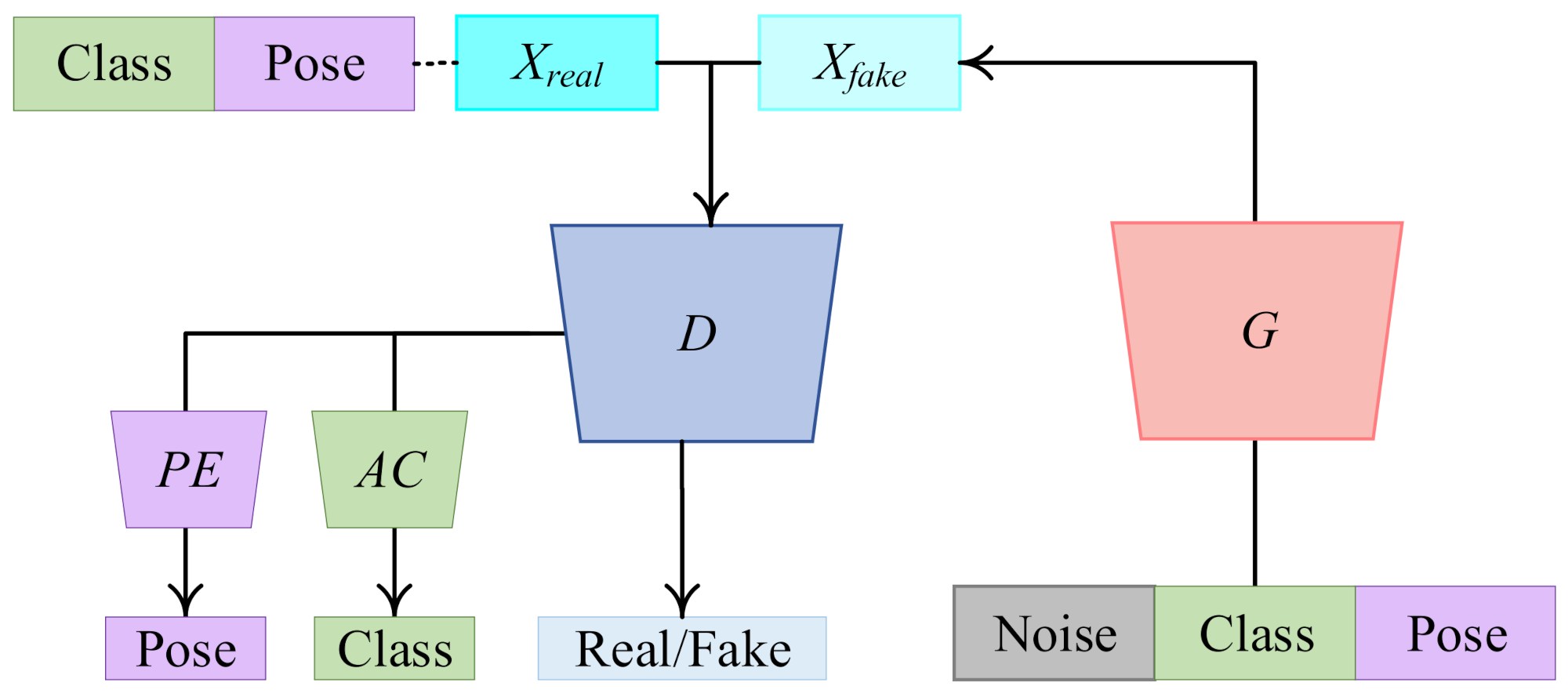
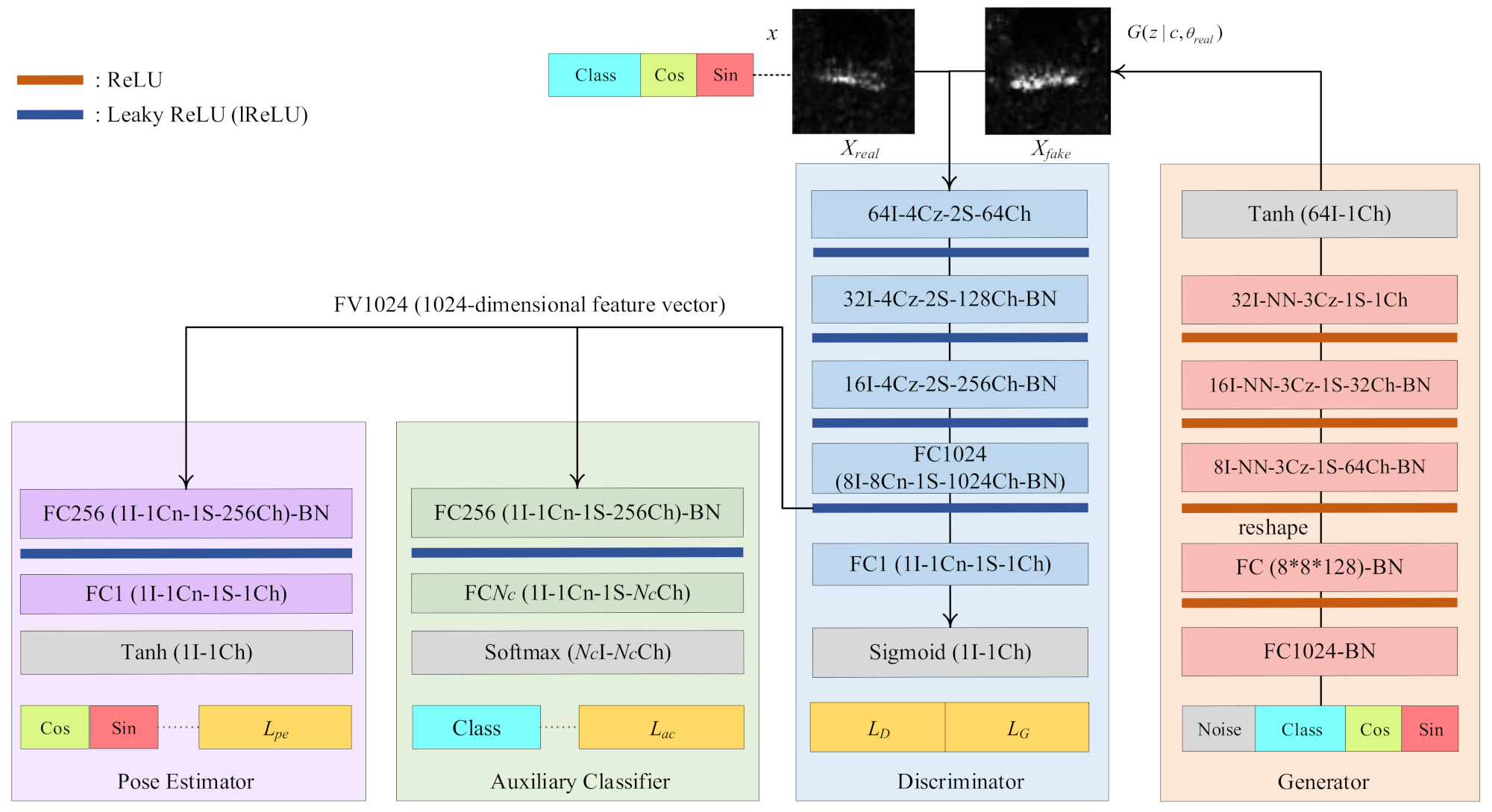

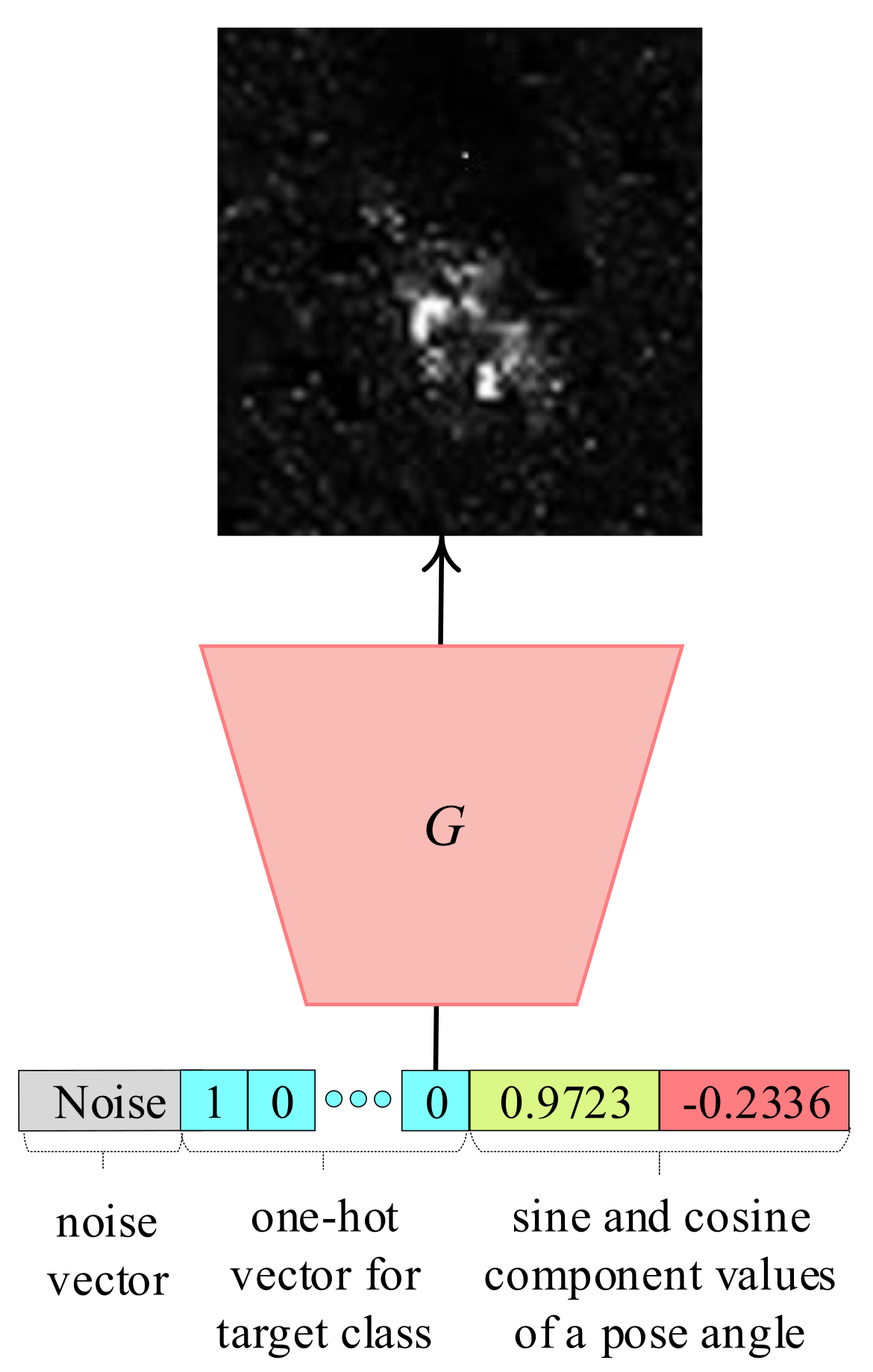

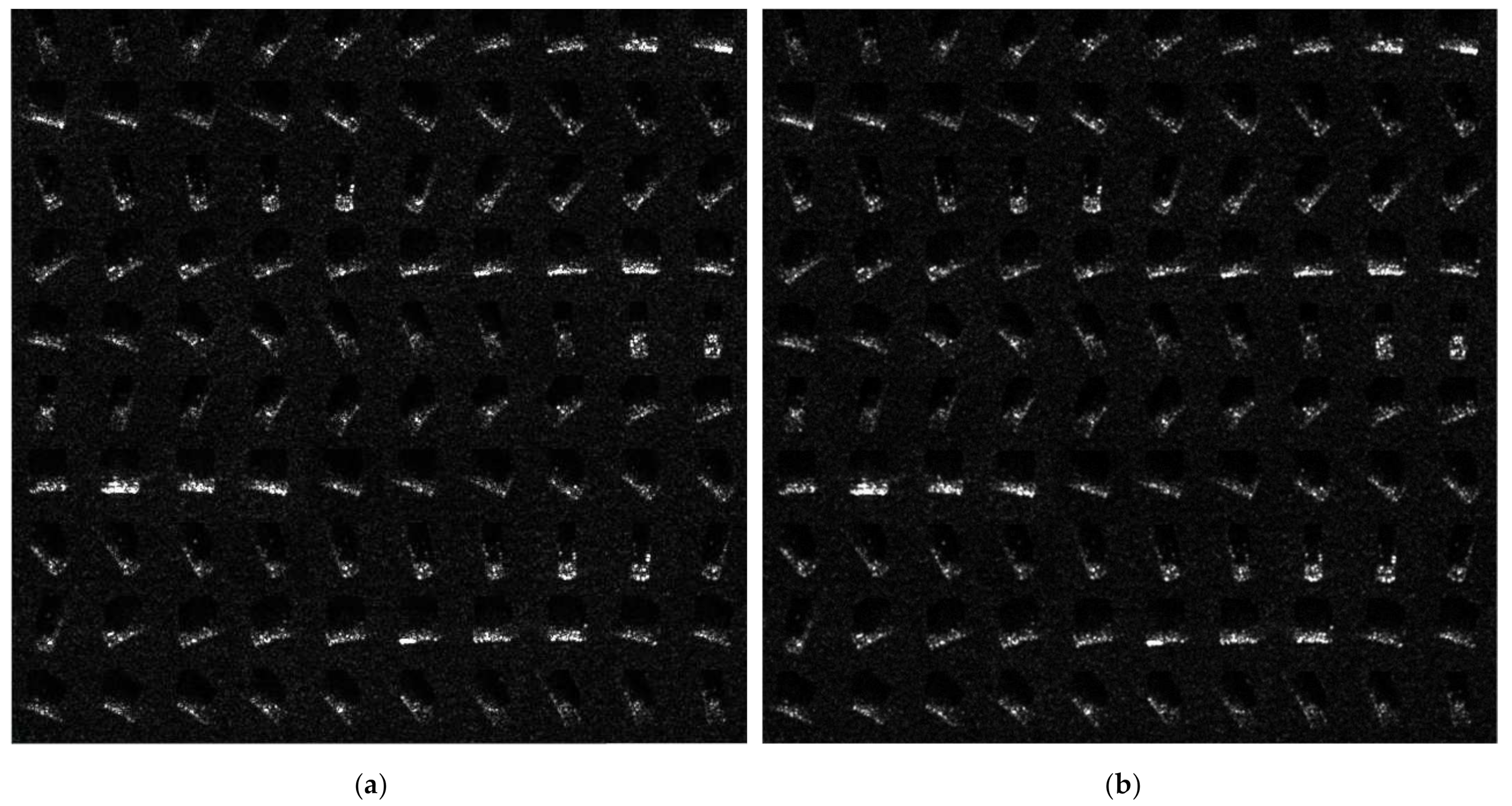

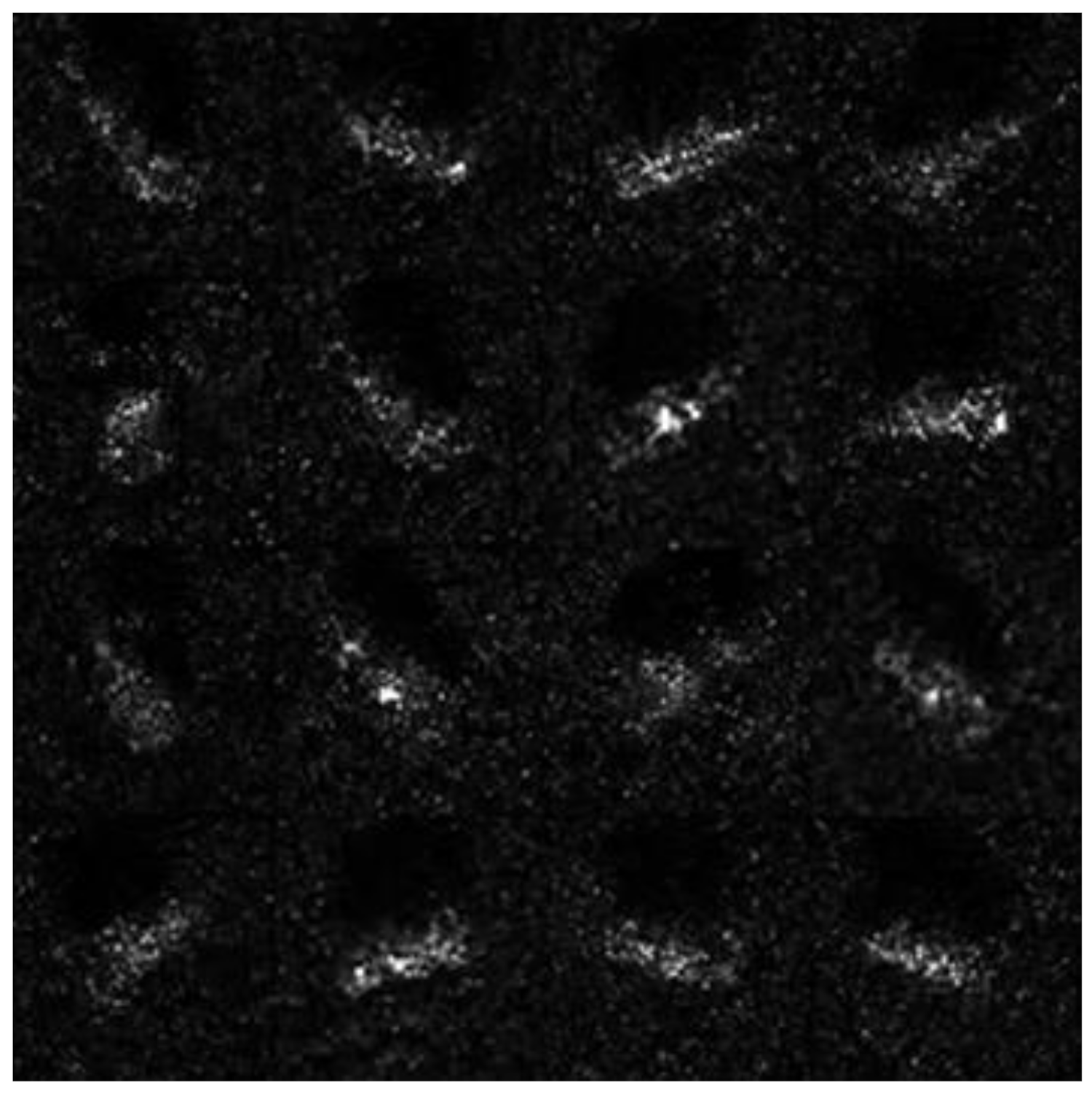



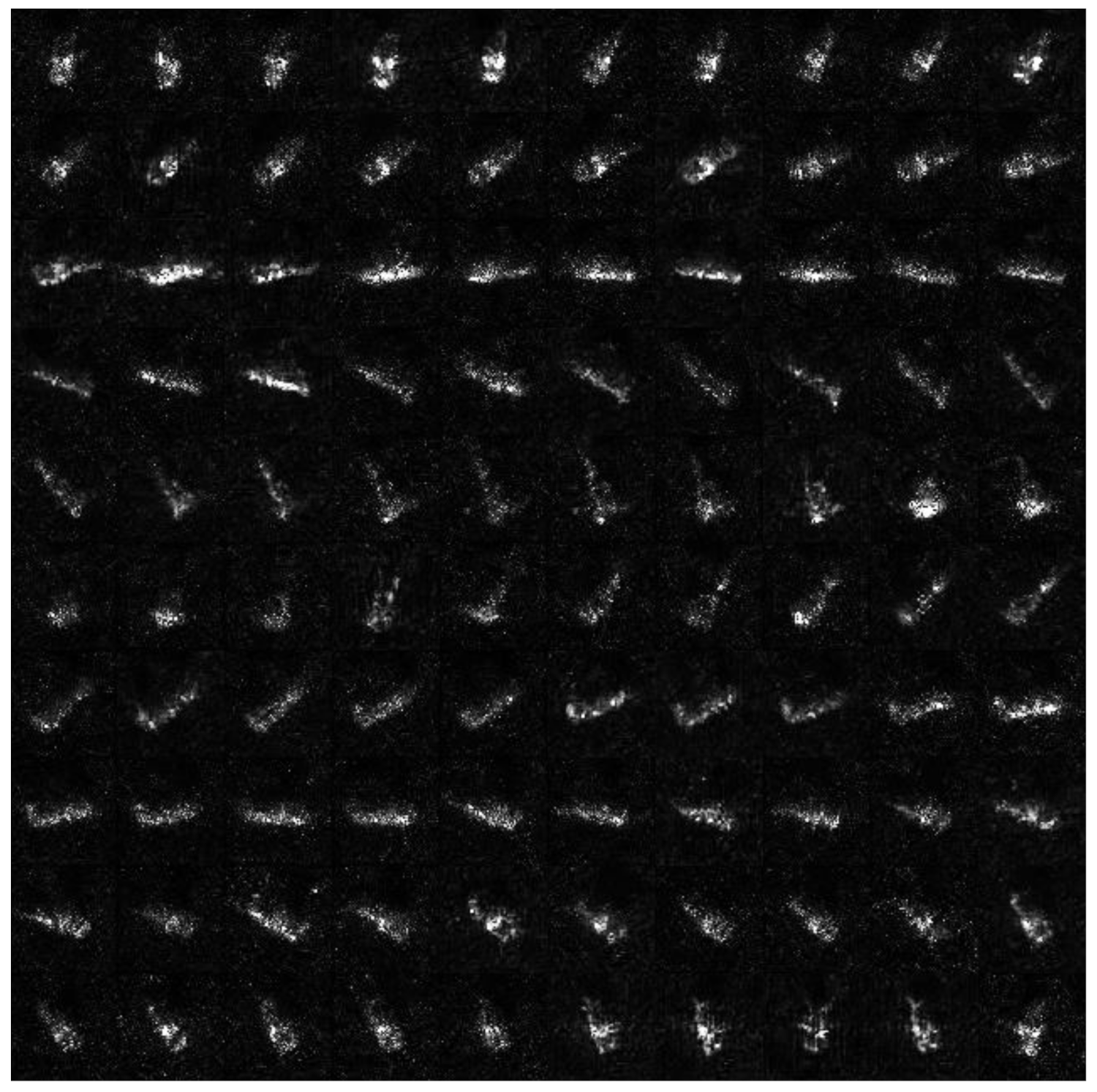
| Target Names (Classes) | Serial # | For GANs, DC and DP (SAR Image Size: 64 × 64) | Only Used for SC (SAR Image Size: 64 × 64) | ||
|---|---|---|---|---|---|
| Depression Angles | # of Data (Total: 2747) | Depression Angles | # of Data (Total: 2425) | ||
| BMP2 | 9563 | 17 | 233 | 15 | 195 |
| BTR70 | C71 | 17 | 233 | 15 | 196 |
| T72 | 132 | 17 | 232 | 15 | 196 |
| BTR60 | K10 | 17 | 256 | 15 | 195 |
| 2S1 | B01 | 17 | 299 | 15 | 274 |
| BRDM2 | E71 | 17 | 298 | 15 | 274 |
| D7 | 92V | 17 | 299 | 15 | 274 |
| T62 | A51 | 17 | 299 | 15 | 273 |
| ZIL131 | E12 | 17 | 299 | 15 | 274 |
| ZSU234 | D08 | 17 | 299 | 15 | 274 |
| Classes | BMP2 | BTR70 | T72 | BTR60 | 2S1 | BRDM2 | D7 | T62 | ZIL131 | ZSU234 | Recognition Rates (%)/Std. |
|---|---|---|---|---|---|---|---|---|---|---|---|
| BMP2 | 230.6 | 1 | 0 | 1.2 | 0.2 | 0 | 0 | 0 | 0 | 0 | 98.97/0.210 |
| BTR70 | 1 | 229.4 | 0 | 2.6 | 0 | 0 | 0 | 0 | 0 | 0 | 98.45/0.210 |
| T72 | 0 | 1 | 231 | 0 | 0 | 0 | 0 | 0 | 0 | 0 | 99.57/0.000 |
| BTR60 | 0 | 4.2 | 0 | 251.8 | 0 | 0 | 0 | 0 | 0 | 0 | 98.36/0.156 |
| 2S1 | 0 | 1 | 0 | 0 | 296.6 | 0 | 0 | 1.4 | 0 | 0 | 99.20/0.164 |
| BRDM2 | 0.2 | 0 | 0 | 1 | 0 | 296.8 | 0 | 0 | 0 | 0 | 99.60/0.134 |
| D7 | 0 | 0 | 0 | 0 | 0 | 0 | 299 | 0 | 0 | 0 | 100.0/0.000 |
| T62 | 0 | 0 | 1 | 0.2 | 0 | 0 | 0 | 297.8 | 0 | 0 | 99.60/0.134 |
| ZIL131 | 0 | 0 | 0 | 0 | 0 | 0 | 0 | 0 | 299 | 0 | 100.0/0.000 |
| ZSU234 | 0 | 0 | 0 | 0 | 0 | 0 | 0 | 0 | 0 | 299 | 100.0/0.000 |
| Averages | 99.42/0.025 |
| Classes | ||||
|---|---|---|---|---|
| MAD | STD | MAD | STD | |
| BMP2 | 2.14 | 3.00 | 7.03 | 11.49 |
| BTR70 | 2.31 | 3.67 | 8.48 | 12.04 |
| T72 | 2.61 | 3.89 | 6.71 | 10.44 |
| BTR60 | 2.16 | 3.47 | 6.71 | 9.55 |
| 2S1 | 1.90 | 2.75 | 6.84 | 10.29 |
| BRDM2 | 2.12 | 2.99 | 6.77 | 10.73 |
| D7 | 2.37 | 3.83 | 7.45 | 10.38 |
| T62 | 2.11 | 2.66 | 6.39 | 10.27 |
| ZIL131 | 2.16 | 2.97 | 5.83 | 8.49 |
| ZSU234 | 2.37 | 3.58 | 6.10 | 8.99 |
| Averages | 2.22 | 3.28 | 6.83 | 10.27 |
| Structures | SC | DC |
|---|---|---|
| PeaceGAN | 81.20 | 99.42 |
| ACGANm | 73.03 | 96.23 |
| CGANm | 77.53 | 95.63 |
| Classes | ||||
|---|---|---|---|---|
| MAD | STD | MAD | STD | |
| BMP2 | 7.03 | 11.49 | 11.59 | 19.28 |
| BTR70 | 8.48 | 12.04 | 10.95 | 18.07 |
| T72 | 6.71 | 10.44 | 11.59 | 19.67 |
| BTR60 | 6.71 | 9.55 | 9.50 | 16.05 |
| 2S1 | 6.84 | 10.29 | 9.67 | 16.99 |
| BRDM2 | 6.77 | 10.73 | 10.61 | 18.38 |
| D7 | 7.45 | 10.38 | 10.61 | 16.41 |
| T62 | 6.39 | 10.27 | 9.61 | 16.98 |
| ZIL131 | 5.83 | 8.49 | 8.85 | 14.23 |
| ZSU234 | 6.10 | 8.99 | 8.72 | 13.32 |
| Averages | 6.83 | 10.27 | 10.17 | 16.94 |
| NTR × Nc | Accuracy (%) |
|---|---|
| 100 × 10 | 20.57 |
| 200 × 10 | 46.43 |
| 300 × 10 | 69.27 |
| 400 × 10 | 79.34 |
| 500 × 10 | 90.06 |
| 1000 × 10 | 95.55 |
| 1500 × 10 | 97.36 |
| 5000 × 10 | 97.81 |
| 10,000 × 10 | 98.10 |
Publisher’s Note: MDPI stays neutral with regard to jurisdictional claims in published maps and institutional affiliations. |
© 2021 by the authors. Licensee MDPI, Basel, Switzerland. This article is an open access article distributed under the terms and conditions of the Creative Commons Attribution (CC BY) license (https://creativecommons.org/licenses/by/4.0/).
Share and Cite
Oh, J.; Kim, M. PeaceGAN: A GAN-Based Multi-Task Learning Method for SAR Target Image Generation with a Pose Estimator and an Auxiliary Classifier. Remote Sens. 2021, 13, 3939. https://doi.org/10.3390/rs13193939
Oh J, Kim M. PeaceGAN: A GAN-Based Multi-Task Learning Method for SAR Target Image Generation with a Pose Estimator and an Auxiliary Classifier. Remote Sensing. 2021; 13(19):3939. https://doi.org/10.3390/rs13193939
Chicago/Turabian StyleOh, Jihyong, and Munchurl Kim. 2021. "PeaceGAN: A GAN-Based Multi-Task Learning Method for SAR Target Image Generation with a Pose Estimator and an Auxiliary Classifier" Remote Sensing 13, no. 19: 3939. https://doi.org/10.3390/rs13193939
APA StyleOh, J., & Kim, M. (2021). PeaceGAN: A GAN-Based Multi-Task Learning Method for SAR Target Image Generation with a Pose Estimator and an Auxiliary Classifier. Remote Sensing, 13(19), 3939. https://doi.org/10.3390/rs13193939






